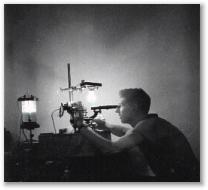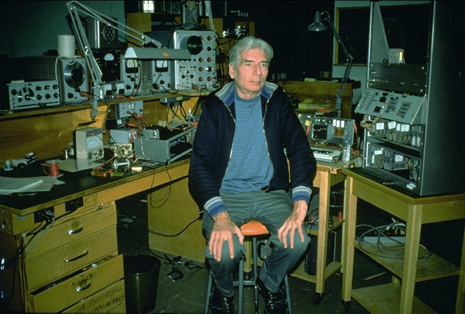|
BIOGRAPHY
Canadian scientist
and composer Hugh Le Caine (1914-1977) has been called one of the
"heroes" of electronic music. He was brought up in Port
Arthur (now Thunder Bay) in northwestern Ontario. At an early age
he began building musical instruments and experimenting with electronic
devices. In his youth he imagined "beautiful sounds" that
he believed could be realized through new electronic inventions.
|

|
| Hugh
Le Caine working in the physics laboratory at Queen's University,
Kingston, Ontario, in 1938 |
After earning his
Master of Science degree from Queen's University in 1939, Le Caine
joined the National Research Council of Canada (NRC) in Ottawa.
There he worked on the development of the first radar systems and
in atomic physics, distinguishing himself as a scientist and publishing
significant papers in those fields.
At home he continued
to pursue his interest in electronic music and sound generation.
He established a personal studio in 1945, where he began to work
independently on the design of electronic musical instruments such
as the Electronic Sackbut, a sophisticated monophonic performance
instrument now recognized as the first voltage-controlled synthesizer.
Le Caine later developed voltage-control systems for a wide variety
of applications.
In 1948 Le Caine
went to England for four years of graduate studies in physics, but
resumed his work in electronic music on his return to Canada. On
the strength of his public demonstrations of his instruments, he
was permitted to move his musical activities to NRC and to work
on them full time in 1954. Over the next twenty years he built over
twenty-two different new instruments. He collaborated in the development
of two pioneering electronic music studios at the University of
Toronto (opened in 1959) and at McGill University in Montreal (opened
in 1964).
Le Caine's lab
at NRC almost single-handedly equipped these early electronic music
studios. The components of the Sackbut were separated into independent
units, or modules, so that composers could assign each one to a
role in a sequence suited to a specific task. Le Caine taught at
both universities, and influenced a generation of composers of electroacoustic
music.
His many articles
and personal demonstrations catalyzed activity both within Canada
and in the international community. He had an indirect influence
on the development of the modular Moog Synthesizer through Gustav
Ciamaga, who was familiar with Le Caine's filters and subsequently
stimulated Robert Moog to design his voltage-controlled low-pass
filter.
Perhaps the most
important aspect of Le Caine's designs for his instruments was the
"playability" that he took care to build into them. His
fixation with "beautiful sound" led him repeatedly to
design electronic instruments capable of producing a nuance-filled
expression typical of the orchestral tradition. He had an acute
sense of what performers needed if they were to be able to create
the performance gestures that he believed formed the essence of
music.
Touch sensitivity
was an essential ingredient in this, and was used in keyboards,
mixers, and other components, applied mechanically, electronically,
and through light sensitivity. Le Caine's designs were so advanced
in this respect that some of the features that he developed found
their way into commercial designs only in the late 1980s.
Ideally, a musical
instrument should offer potent sound resources and manageable control
systems. These goals are not always compatible. Realizing the musical
potential of traditional instruments usually requires intensive
training. With his electronic instruments Le Caine attempted to
change this balance in the direction of playability without compromising
musical integrity. Each design was a unique study in balance, elegant
and beautiful. Throughout his years as a designer, Le Caine composed
a number of short pieces and studies which were intended to explore
and demonstrate the possibilities of the new instruments.
His 1955 composition
"Dripsody," based on the sound of a single drop of water,
must still rank as the most-played example of "musique concrete."
Regardless of the acclaim they rightfully achieved he continued
to express a disparaging attitude towards his compositions: "I
did not regard myself as a composer. However, I felt that the only
way to understand the composer's interest in the apparatus was to
try to use the equipment myself in the various current musical forms."
His self-deprecating
sense of humour is evident in some of the titles he chose for his
compositions, such as "A Noisome Pestilence." When someone
asked why he had called his first composition "Dripsody,"
he replied: "Because it was written by a drip."
 |
| Hugh
Le Caine in his lab at the National Research Council in 1974
surrounded by his inventions |
In the studies on this CD we see the same imagination and originality
that is so evident in the instruments themselves. This recording illustrates
the wide range of techniques which Le Caine pioneered, highlighting
eight of his instruments. It also shows something of his personality
and sense of humour.
Although Le Caine's
instruments are discussed individually, they were intended to work
together within the context of the electronic music studio, one
controlling another, or one feeding sounds to another, in configurations
which varies from one application to another.
All of Le Caine's
studio instruments could be used in combination with one another
in this way. Modular units such as touch-sensitive keys appeared
in several instruments and were used for varied purposes. The sheer
intelligence and insight of Le Caine's ideas continue to deserve
an audience. Consider his comment from 1966 that "What a composer
of electronic music needs most is not an understanding of the apparatus,
but a new understanding of sound."
Le Caine retired
from the National Research Council in 1974 after the failure of
the Sackbut manufacturing project.
Le Caine died in
July of 1977 as a result of injuries incurred in a tragic motorcycle
accident on July 4, 1976.
Eccentricities
 |
| "Colossal
Dahlia-flowered Zinnias" |
In this photo composition
Hugh Le Caine is seen among huge flowers. He had placed a cardboard-backed
enlargement of a full-length photograph of himself among the flowers
in the roof garden in his home/studio. He then rephotographed the
assembly and proudly showed his colleagues the size of his flowers.
 |
| Le
Caine and motorcycle in 1948 |
Le Caine had a passion for driving motorcycles at high speeds on
Canadian highways. He impressed his colleagues by setting unofficial
speed records between Montreal and Northern Ontario.
 |
|
The
Le Caine House
|
The garden behind Le Caine's home supported a dense growth of flowering
trees and brushes, with a brick pathway and patio area. There was
no lawn either in front or in back of the house.
|
